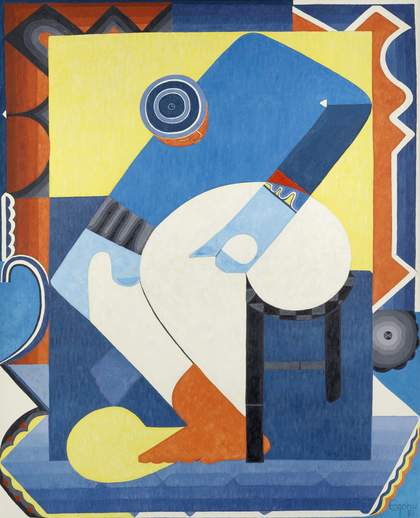
Uzo Egonu, Stateless People an artist with beret 1981. © The estate of Uzo Egonu. Private Collection.
This autumn, Tate Modern will stage the first UK exhibition to trace the development of modern art in Nigeria. Spanning a period from indirect colonial rule to national independence and beyond, Nigerian Modernism will celebrate an international network of artists who combined African and European traditions, creating a vibrant artistic legacy. The exhibition will present the work of over 50 artists across 50 years, from Ben Enwonwu to El Anatsui. They each responded to Nigeria’s evolving political and social landscape by challenging assumptions and imagining new futures, reclaiming Indigenous traditions to create a new African vision of Modernism. Featuring more than 250 works, including painting, sculpture, textile, ceramics and works on paper from institutions and private collections across Africa, Europe and the US, it offers a rare opportunity to encounter the creative forces who revolutionised modern art in Nigeria.
The exhibition will begin in the 1940s amid calls for decolonisation across Africa and its diaspora. With the Nigerian education system under British governance, many artists trained in Britain, adopting European artistic techniques and witnessing Western modernism’s fixation on African art. The balance between Nigeria’s Indigenous traditions, colonial realities and calls for independence was evident in the practices of artists, many of whom became involved in arts education and reform. Aina Onabolu pioneered new figurative portraits of Lagos society figures, whilst Akinola Lasekan depicted scenes from Yoruba legends and history. Globally celebrated artists of the period, Ben Enwonwu and Ladi Kwali, combined their Western training with Nigerian visual art traditions. Drawing upon his knowledge of Igbo sculpture, Enwonwu adapted his Slade School education to celebrate the beauty of Black and African culture. Meanwhile, Kwali who trained under British potter Michael Cardew at Pottery Training Centre in Abuja, developed a new style of ceramic art that synthesised traditional Gwarri techniques and European studio pottery.
National independence on 1 October 1960 inspired a sense of optimism throughout the country, with artistic groups creating art for a new nation. The exhibition will look at the legacy of The Zaria Arts Society whose members included Uche Okeke, Demas Nwoko, Yusuf Grillo, Bruce Onobrakpeya and Jimo Akolo. Encouraged by teachers like Clara Etso Ugbodaga-Ngu, they developed independent creative styles centred around a concept of ‘Natural Synthesis’, merging Indigenous forms with modern expression. In the 1960s amid an economic boom, Lagos became a dynamic cultural hub, inspiring tropical modernist architecture, public art commissions and nightclubs filled with Highlife music. Meanwhile in Ibadan, The Mbari Artists’ and Writers’ Club founded by German publisher Ulli Beier, offered a discursive space run by an international group of artists, writers and dramatists including Chinua Achebe, Wole Soyinka, and Malangatana Ngwenya. The Mbari Club was closely associated with the influential Pan-African modernist journal Black Orpheus, which will be displayed at Tate Modern.
During this period, many artists reflected on Nigeria’s rich cultural and religious heritage as home to more than 250 ethnic groups. The late 1950s saw the emergence of the New Sacred Art Movement, founded by Austrian born artist Susanne Wenger who drew on Yoruba deities and beliefs to explore the ritual power of art. The group led the restoration of the Osun-Osogbo Sacred Grove where ancient shrines were adorned with cement sculptures and carvings. In parallel, The Oshogbo Art School emerged out of series of influential workshops at Duro Ladipo’s Popular Bar providing a space for experimentation among untrained artists and performers including Nike Davies-Okundaye, Jacob Afolabi and Twins Seven Seven who explored Yoruba cultural identity and personal mythologies in their work.
The outbreak of the Nigerian Civil War in 1967 caused a cultural and political crisis for many artists. The post-independence feeling of optimism and unity were replaced with division, and later a desire to reconnect across Nigeria’s diverse ethnic groups. The exhibition will look to the revival of ‘uli’ - linear Igbo designs which can be decorative or represent natural elements and everyday objects. Historically passed down between women, artists like Uche Okeke who had inherited this knowledge from his mother, and those from the Nsukka Art School including Obiora Udechukwu, Tayo Adenaike and Ndidi Dike, adapted this visual language as a modernist art form, reclaiming an element of ancestral culture and reflecting on the struggles of conflict during the Nigerian Civil War.
The exhibition will end with a spotlight on Uzo Egonu, exploring how artists towards the end of the 20th century began to respond to global Nigerian identities. Living in Britain since the 1940s, Egonu’s work was informed by his perspective as an expatriate, creating works imbued by his childhood memories and feelings of nostalgia, as well as his response to current events, observed from overseas. The exhibition will bring together Egonu’s Stateless People paintings, the first time these works have been reunited in 40 years. Begun in 1980, the series reflects on questions of nationhood and cultural identity. Depicting a single figure in each painting - a musician, artist and writer - Egonu represents the growing visibility of Nigeria’s diaspora around the world. The series sums up the tension between national identity and artistic independence which shaped Nigeria’s story of modern art.
